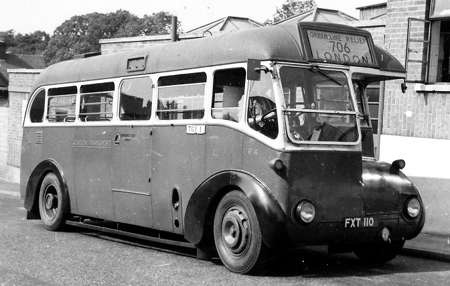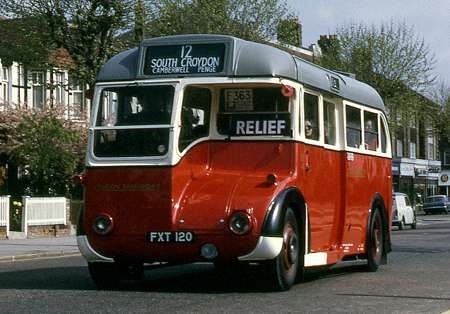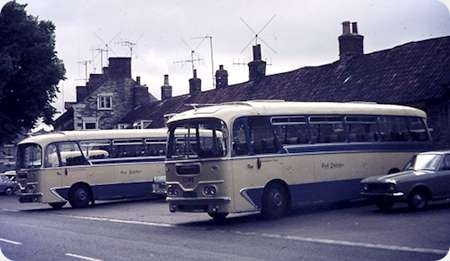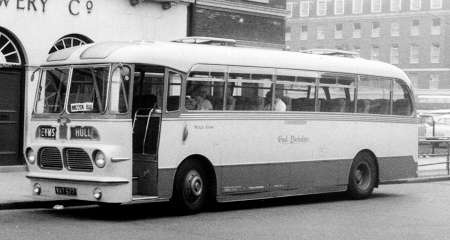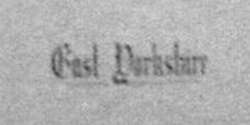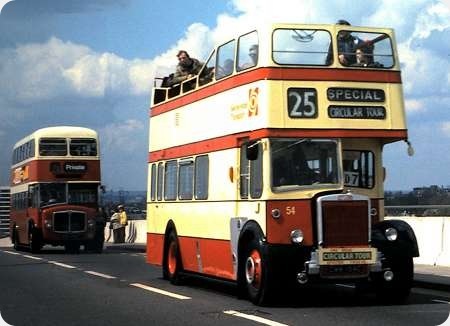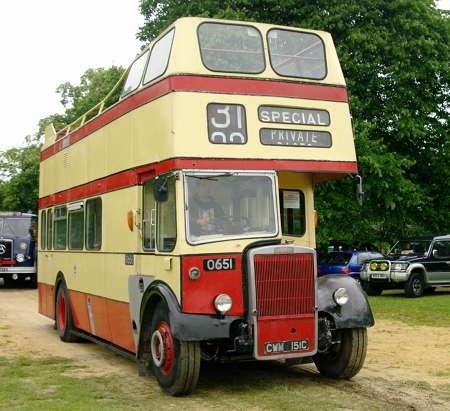London Transport – Leyland REC – FXT 122 – CR16
London Transport
1939
Leyland REC
London Transport B20F
FXT 122 is a Leyland REC with LPTB B20F bodywork. She dates from 1939 and is seen at Longcross, Chobham, on one of those occasions that “Wisley” wasn’t at Wisley. In the Jenkinson listing of 1978, the REC is translated as Rear Engined Cub, which may or may not be correct. According to Ian Smiths London Transport website the CR in the fleet number stood for Cub Rear
Photograph and Copy contributed by Pete Davies
31/12/15 – 13:00
I believe the vehicle is rear engined and was the first rear engine PCV class.
I thought they were AEC rather than Leyland but would not wager any money on it.
The styling is Q related I think and was the Q single decker the first inclined mid-engined PCV?
Having looked on the internet it seems I would have lost my money as all references seem to be Leyland
Roger Burdett
31/12/15 – 13:02
I’ve been waiting for one of these to come up, here is a shot for the other side.
Mr Anon
01/01/16 – 07:04
Sorry, Roger. Definitely a Leyland. Perhaps even AEC weren’t brave enough!
Pete Davies
01/01/16 – 07:05
What was the gear selection system on these vehicles. Were they manual or semi-automatic. Also, were they one-man operated or crew. Two very interesting photos.
Norman Long
01/01/16 – 10:56
I cadged a brief ride that day at Longcross and I’m sure that the gearbox was a conventional 4-speed. The engine (indirect injection) sounded remarkably like a Perkins P4, with that characteristic combustion tinkle, and it has the same bore and stroke. The rear hubs fooled me: I guessed they must be double-reduction, but apparently they house universal joints at the outer end of each cardan shaft, as the axle is arranged on the de Dion principle, which doesn’t give independent suspension but does cut down unsprung weight by mounting the differential either on the chassis or in unit with the gearbox.
In the late forties on a visit to my aunt and uncle’s at Ealing, Mx, somewhere near Brentford(?) from the window of another bus I saw one of these vehicles, which looked very strange—even slightly creepy—to my 8-or-9-year old eyes.
Fine restoration job, and thanks to the owners for saving another rare bus, full of innovation and individuality.
Ian Thompson
02/01/16 – 06:45
Ian is correct in his description of the CR, which was built at Leyland’s Kingston factory (actually in Ham) which had once produced Sopwith aircraft. The six cylinder indirect injection engine, which had been developed for the later production Cub KPO3, had a capacity of 4.7 litres developing 65 bhp, and it was mounted longitudinally at the rear of the chassis frame. The radiator was also located at the rear. The engine cover inside the vehicle was equipped as a luggage rack. The gearbox was the standard Leyland four speed “silent third” – sliding mesh 1st and 2nd, helical 3rd. Given the limitations conferred upon the passenger capacity of this small vehicle by the engine layout, it was particularly galling for the LPTB to have to adopt a space wasteful front end design similar to that of the contemporary underfloor engined TF (Tiger Flat) Green Line coach model. Had the doorway been located in the logical position ahead of the front axle (as was the 5Q5 version of the AEC Q) then the Metropolitan Police would have insisted upon an open, doorless entrance. It is often stated that the production of the CR was curtailed by the outbreak of war, but this is not the case. Always prone to over ordering, the LPTB originally decided that it required 73 examples in addition to the prototype. Having redone the sums, this was cut to 58, and then to 48. All, except the 1937 prototype, were delivered after the start of the war, the last arriving in December 1939. Many of them saw service in the first year or so of the war, but then went into storage in 1942. Several went into storage in 1939 from new. They began to reappear in 1946 when their original function had largely been usurped by larger buses. Instead they were employed on Central Area routes with conductors to meet the pressures of post war demand, and proved woefully unequal to the task. Breakdowns were frequent and spares in short supply. By the early 1950s they had all gone.
Roger Cox
02/01/16 – 08:50
Another bus spotters’ delight…….and operators’ nightmare! Thx for your usual detailed information, Roger, especially the gearbox information which I’ve always wondered about and which even the London Bus Museum website doesn’t explain. Although Merton Garage had the odd one allocated to it (Sutton didn’t, to my knowledge), I never saw one around my area at all.
The Town & Country Act of 1947 rather ‘did’ for expansion of London (and other cities), where unbridled ‘ribbon’ development stopped, handicapped, in any case, by a lack of building materials. The ‘Northern Heights’ extension of the Tube’s Northern Line, plus some other Tube bits and pieces, were never completed and the CR’s intended feeder services never expanded.
Chris Hebbron
02/01/16 – 17:51
According to the Ian’s Bus Stop website, Merton (AL) did get at least 4 CRs in 1946/7 – including one in green livery – mainly for route 88, and Sutton (A) at least two for the 213 and latterly 93.
The 1 1/2 deck Leyland Cubs designed for the ‘inter station’ route and a number of single deck buses (including some pre-war Green Line coaches) also saw central bus service (on routes with a double deck allocation) around this time.
All were crew operated – the OMO agreement for central buses had by then lapsed, and the practical (and industrial relations) complications of having one or two OMO buses on a crew route would have been a bit too much to handle.
Operationally, I understand that the single deckers only ran on ‘spreadover’ workings (i.e. peak hours only) and I would have thought that if any garage had more buses than crews on any day, the single deckers would have been left in the garage.
Hired in coaches followed in 1947, and new Bristol Ks diverted from ‘Tillings’ companies followed in 1948.
Jon
03/01/16 – 06:11
Correction to my earlier comment! What I glimpsed at Brentford (?) all those years ago was probably not a CR but a TF, whose existence I’d forgotten all about until reading Roger’s reference to it. I recall the mystery bus as being of normal length. As I know practically nothing of what LPTB buses ran on which routes, perhaps someone—Chris H, perhaps—could say whether TFs did or didn’t go through Brentford. The combination of 8.6-litre Leyland engine and epicyclic gearbox in the TF must have made for a very tuneful ride.
Ian Thompson
03/01/16 – 10:43
CR’s and TF’s did have a generic likeness, Ian, and green CR’s did run in Central services and vice versa at times, adding to the confusion. The TF’s ran the Green Line services and you will be interested in that the 701 ran from Gravesend to Ascot, passing through Brentford, from 1946 to 1975, as did the 702 from Gravesend to Sunningdale from 1946 to 1973. I did travel on a few TF’s and they did exude an aura of understated luxury.
Chris Hebbron
06/01/16 – 16:37
Thanks, Chris H, for confirmation that TF passed through Brentford. The vehicle through whose window I snatched that one childhood sighting will have been a trolleybus on the 655 route. Incidentally, my only LT ride (on the long back seat for 5 upstairs where you can look down onto the staircase) was with the same Ealing aunt, and I’m sure the bus said “Hammersmith” on the destination box. Chiming gearbox and snuffly petrol engine that seemed to backfire occasionally; six wheels; straight staircase; what more could any bus-mad kid wish for? Up to what date could that have been? Thanks in advance for any info.
Ian Thompson
07/01/16 – 06:08
Probably 1949.
According to Ken Glazier’s book ‘Routes to Recovery’ (about London Transport in the immediate post war years) the last double deck LTs were withdrawn in January 1950, the last examples running from Upton Park garage on route 40 (which didn’t go anywhere near Hammersmith)
Apart from the last scheduled allocations, a number were spread around garages to supplement the scheduled allocation until late 1949.
From Ian Armstrong’s ‘London Bus Routes’ website –
Hammersmith (Riverside) garage had a fairly substantial allocation of LTs on routes 11 and 17 (London Bridge – Shepherds Bush – no relation to the later north London incarnations of the route number) and 73 until 1949.
Mortlake’s routes 9 and 73 had LTs until 1948 and 1949 respectively (some at Mortlake were initially replaced by green RTs as deliveries had got out of step with needs).
Jon
07/01/16 – 06:10
Many LT’s were based at Leyton, Loughton and Potters Bar Garages, on your side of London, Ian. LT’s mainly left those garages around 1947/48, but were still to be found in decreasing numbers ALL around London until the final deathnell came in February 1950. Even two of the first 150 open-staircase ones survived to the end by then some 20 years old. These were due to replaced in 1942, had the war not intervened. I had a lucky escape from an open-staircase one as a baby. An aunt of mine was climbing the stairs with me in her arms, when she slipped and lost hold of me. A passer-by at the rear of the bus, by chance, caught me in the nick of time. Of all the LT’s, my favourite was the last ones made, in 1931, called Bluebirds. See here: //tinyurl.com/zllt7hk
Chris Hebbron
13/01/16 – 06:02
Thanks, Jon and Chris H, for the information on LT routes and dates.
Very nearly having my school cap blown off on the stairs of open-staircase Titan Reading 36 (RD 777) seemed exciting at the time, but that hardly compares with Chris’s extraordinary rescue!
Thanks also for the Bluebird link. LT741 is a very rationally-designed and handsome vehicle, and the superb interior shots answered all sorts of questions. Pity that no Bluebirds survived, but we can say that of a host of fascinating vehicles that live on only in tantalising photographs.
Ian Thompson
12/04/16 – 06:11
Here is a picture of CR 14, FXT 120, taken at South Croydon during the HCVC rally in May 1972. This bus was delivered in 1939 and went into service in Country Area Green livery at Windsor garage before being withdrawn into store along with the rest of the class by 1942. In 1947 it was overhauled and repainted into Central Area red livery, though the purpose of this expensive exercise appears somewhat elusive as it was only used by Chiswick as a training vehicle during 1948. Just one year later, in 1949, with characteristic profligacy, London Transport then repainted the bus back into Country green for service on rural route 494 between East Grinstead and Oxted via Tandridge, Lingfield and Felcourt, a route that then became a Guy GS operation after the the surviving members of the CR class were withdrawn entirely in 1953. CR14 was selected as an exhibit for the LT Clapham Museum, but, in 1967, it was sold off into private preservation. Although in the photo the vehicle is shown with route 12 destination blinds, the probability of a CR being used on that very busy route must have been remote in the extreme. However, it does seem that some examples of the class may have been used occasionally in the Croydon area for Relief duties on route 68 (South Croydon – Chalk Farm).
Roger Cox
30/08/16 – 06:46
I can confirm that red CR buses were indeed used on the 68 route. I used to often see “two of them” (numbers unknown) parked at Beulah Hill, junction with Spa Hill (Norwood) on my way to secondary school. I’ve no idea why there was need for two of them. My intelligent guess is that this would have been in the late 40s or very early 50s.
Derek
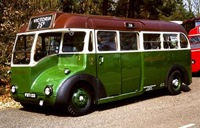 Vehicle reminder shot for this posting
Vehicle reminder shot for this posting
20/09/16 – 07:06
Among the first rear engined buses were the SOS REC type built by The Birmingham & Midland Motor Omnibus Company, better known as Midland Red in 1935. The company didn’t find them successful and rebuilt them with underfloor engines.
Mr Anon
21/09/16 – 05:49
Since the CR vehicles were based on the Leyland REC chassis, Ian, was there any connexion between the SOS REC’s and Leyland’s, or was it merely a coincidence of titling?
Could someone come up with more information on BMMO’s SOS REC’s?
Chris Hebbron
22/09/16 – 07:12
Chris, there are some details of the SOS RECs on
//MidlandRed.net
There were four of them fitted with transverse mounted petrol engines so I think only the name was the same.
Gary Thomas
Quick links to the - Comments Page - Contact Page - Home Page

